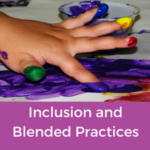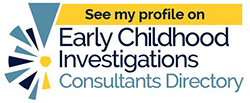 One of my first introductions to children with disabilities was in a “reverse mainstreamed” preschool program in Pocatello, ID back in 1990 or maybe 1991.
One of my first introductions to children with disabilities was in a “reverse mainstreamed” preschool program in Pocatello, ID back in 1990 or maybe 1991.
Even at that time, with no formal education regarding philosophies, strategies, or models for teaching young children with identified disabilities, the idea of reverse mainstreaming seemed “off.”
In other words, I didn’t see why we had a separate class for the children on Individualized Education Plan (IEPs). Further, I didn’t understand who and when it was decided that “other” children would visit our classroom.
Fast-forward to 2015, and I, like many others, are still asking: Why is there still a mentality of “separate but equal”? Why do families have to “push” for inclusion? Why is it still general education or special education?
Why isn’t inclusion just a given? After all, isn’t it everyone’s right?
My colleague, Dr. Jennifer Grisham-Brown, and I have spent many years thinking about these very questions.
In an effort to offer answers and identify solutions, we started using the term “blended practices.”
Blended practices are the integration of practices that can be used to address the needs of all children in inclusive settings” (Grisham-Brown & Hemmeter, 2017).
We shifted to the term blended, in an effort to move away from the “baggage” that seemed to bog down #inclusion, and to move to something “bigger.”
Our dream is to think of inclusive practices as a “given,” not as an after thought…something that “is how it is”…not something that is up for discussion or debate.
Basically, we use the term blended to represent instruction that is designed with ALL children in mind (e.g., children who are typically developing; children with developmental delays; children who live in poverty; children who are not part of the majority culture; children who speak another language).
Blending can be thought of as the act of combining philosophies and practices from across disciplines.
For us, blending “smooths” the implied forced choices among colleagues, policies, and paradigms, and expects the creation of flexible environments, characterized by data-driven choices for successful intervention.
In particular, blended practices are built upon three key principles:
1. Regardless of label, funding, or ability, children have the opportunities & supports to thrive.
2. Variability of instruction needs to match the variability of early development.
3. Authentic assessment is the heart of designing and delivering quality early education.
So what do blended practice principles look like in action?
Here are a few examples and, as always, I’d love to hear how you’ve blended practices and how it looks in your world:
- Children are seen as individuals and separate from their labels.
- Instruction is differentiated to allow children to access, participate, and make progress.
- We don’t try to predict or dictate when “mastery” of outcomes will be demonstrated.
- We don’t set arbitrary benchmarks for development and learning to occur.
- Functional information is routinely collected by familiar people in familiar settings.
- We use authentic assessment information to guide and inform all decisions.
Blended practices build upon all children’s innate curiosity to learn.
Want to learn more about blended practices? Here are a few suggestions:
- Order a copy of Young Exceptional Children’s Monograph #16 on Blended Practices.
- Additional readings:
- Grisham-Brown, J. L. & Pretti-Frontczak, K. (Eds.). (2011). Assessing young children in inclusive settings. The blended practices approach. Baltimore, MD: Paul H. Brookes Publishing Co.
- Grisham0Brown, J. L., & Hemmeter, M. (2017). Blended Practices for Teaching Young Children in Inclusive Settings (2nd ed.). Baltimore, MD: Paul H. Brookes Publishing Co.
